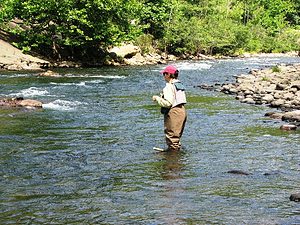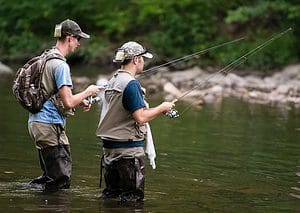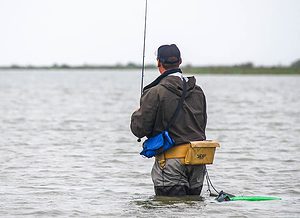Disclosure: Some posts contain affiliate links, which earn us a commission if you make a purchase through them. Positive Fishing © participates in various affiliate networks including the Amazon Services LLC Associates Program.
There is nothing quite like wade fishing. You’re directly connected to the water; you can feel the current, how warm the water is, how the ground changes underfoot, and much more. Nothing beats it in my eyes, and standing on the bank or on a boat doesn’t compare.
But Wade fishing doesn’t come without its challenges. You might be more connected to the water but will also have to manage it.
If you’re not careful, you can step on a stingray on the flats, slip on a rock in a trout river, and be swept downstream in the currents of a big salmon river. Fishing in the water also makes life a little more complex.
Join me as I run through everything you’ll need to succeed at wade fishing and stay safe while doing so.
Wade Fishing Environments, Safety, & Tips

along the bottom and feel your way
Before we get the ins and outs of wading, let’s first think about what environment you will do it in.
Once you understand your surroundings, you’ll be safer while wade fishing, and you should start catching more fish because of it. So where are you going to be wade fishing?
Wade Fishing Tidal Saltwater Flats
Tidal saltwater flats in places like Belize in Central America, and especially the islands of Seychelles are some of the most sought-after fishing destinations on the planet. While wading these flats, you’ll be looking for fish like permit, bonefish, triggerfish, and GTs in knee-deep water.
Yes, it sounds idyllic, and it is when you are walking through crystal clear water looking for these amazing saltwater species to catch, but a lot can go wrong.
How To Be Safe
In these environments, you can walk past a shark and stingrays, which can happen very often. They can do a lot of damage to your feet if you’re not careful. The bottom can also be covered with poisonous shells, sea urchins, and coral, which will also do some potential harm to you.
Another thing you need to be aware of when wading on saltwater flats is the tide. You can find yourself looking for fish near a reef at low tide, get too focused, turn around 40 minutes later, and there is a mile of water between you and the land or your boat that wasn’t there before.
Walking through water is hard work and can sap you full of energy quickly through a day of fishing; depending on the current, it can be up to five times harder than walking on land.
Also, when you’re wading in these tropical environments, it’s very hot, and there is no shade. You’ll need a hat, buff, a long-sleeved PFG shirt, and lots of water to drink in a well-designed water bottle so you don’t get sunstroke or become overly dehydrated.
Always carry a pair of polarized sunglasses to prevent glare and help you sight fish, and also apply quality ECO-friendly sun cream for protection in these hot and sunny situations.
Tips For Wade Fishing Saltwater Flats
No matter what species you’re wade fishing for, make sure you’re walking slowly on the flats as the water might be clear, but the fish can appear out of nowhere, especially permit fish.
You should always be walking while scanning the water from 15 feet in front of you to as far as you can see and in a fan movement. This will help you spot fish from far away, and the earlier you spot them, the more time you’ll have to get ready and put your fly or lure where it needs to be.
Always pay special attention to the tides, as these will be what causes the fish to be where they are at that specific point in the tide. If you see a permit in a specific spot, write down the tide information, and chances are, it’ll be there again on the next exact same tide!
Managing your line is also important when wading the flats. Since you’re sight fishing, the time between casts can be upwards of 20 minutes, which is more than enough time to create a tangle. The last thing anyone needs is a tangled line when you want to cast at the fish you have been waiting for all day.
Wade Fishing Trout Rivers
Trout rivers are another environment where you will find yourself wade fishing, and while they are very different from saltwater flats, they can also be tricky. Walk and wade fishing requires practice, and in a short time, you will gain confidence to fly fish for brown and rainbow trout in the Argentina Patagonia region or on your local stream while fishing in Bluff country, Minnesota.
Safety
Trout rivers can be shallow with gravel bottoms, which makes wading them very easy and safe, but others can have muddy bottoms and be wide with potholes that you can fall in or lose your footing if not super careful.
Every step you take in a trout river differs from the next. Ensure you have a firm footing on each move and won’t fall into a deep hole. More than not, you’ll be wearing waders, and waders full of water cause nothing but danger and trouble.
It is highly advisable to take a wading stick or a wading staff. These give a better way of probing your way forward as you move and act as a third leg to create a much better balance.
Keep an eye on the river’s flow, too, especially if it’s tailwater, as when dams and reservoirs release water into rivers, it can cause an intense current to arrive out of nowhere.
Also, let’s say you’re trout fishing in Yellowstone National Park. It’s a magical place to fish and is one of the most beautiful places I have cast a line in my life. But, when you’re wading the rivers in Yellowstone, you have to stay alert. Huge creatures like bears, moose, and bison drink from the river and must be respected.
Think about the environment the river is in. It might not be in Yellowstone, but there is always something to be aware of. I have also been charged by a herd of cows while fishing a river in a Dorset chalk stream that ran through farmland. Luckily, I heard them just in time to reach the other side of the river!
Tips For Wading Trout Rivers

Trout are notoriously spooky and always on guard from attacks by predators like pikes and large birds. Now add the sound of you noisily wading through the water and all the trout in your vicinity have up and left.
Walking quietly so the fish don’t hear you is key to your fishing success when wading in a river or anywhere. Another smart way of wade fishing a trout river, which I’m sure you know, is by only moving upstream.
Trout will face upstream 90% of the time, and therefore, by walking upstream, you don’t risk them seeing you or hearing you as easily. Also, when you’re walking in a river, you’re moving mud or small stones, and therefore, you’ll often create a trail that is not what you want to fish into.
When wade fishing a trout river, you should also be conscious of the foliage behind you, your casting angles, and all the spots you want to fish.
As you wade up a river, plan a route to all the spots you want to cast to that creates the minimal amount of disturbance possible while letting you have the right casting angles so as not to get caught in a tree. This isn’t easy, but trying to do it will make a difference.
Wade Fishing Salmon & Steelhead Rivers
The reason I have separated out salmon and steelhead rivers from trout rivers is that they tend to be a lot larger with stronger currents, and when fishing for these species, you’re walking downstream, not upstream, and swinging flies across the current.
Safety
Staying safe on a large river has a lot to do with respecting your environment. Large rivers can have incredibly strong currents, and unless you want to be Brad Pitt being swept down rapids in “A River Runs Through It,” take every step with respect.
Don’t try to cross the river in a place where you have any doubt if you can get through the current, and the same goes for depth. If you walk too deep into the river, fall in a hole, and your waders fill with water, that’s your fishing day done, and you’re risking your life, too. At times like this, wearing a wading belt to hold all necessary accessories and personal belongings is key to safe fishing.
Some big rivers also have notoriously slippery rocks, and if you have ever waded in Scottish salmon rivers, such as the River Dee, you’ll know it’s like dancing on ice. Be prepared with the right footwear and go slow.
Tips For Wade Fishing Salmon & Steelhead Rivers
When wading in rivers dominated by salmon and steelhead, you’ll work your way down a pool and then onto the next one. Now, you don’t want to work the pool too quickly as you want your lure or fly to get in front of fish as much as possible, but you don’t want to walk too slowly.
Salmon and steelhead are notoriously annoying to catch, requiring a lot of patience and often the right fish. You’re not going to find the fish that is willing to eat by staying in the same pool, so you’ll want to keep moving.
I tend to move down a pool by three steps with every cast to fish it properly and get onto the next one.
Wade Fishing In Lakes
Wade fishing in lakes is far easier than moving waters such as rivers. However, safety still is important when dealing with the depth of the water. Move slowly, and where possible, use a wading stick to feel the depth and the bottom of the lake for soft areas or rocks that may trip you up.
One additional item is to try to keep as still as possible in the water. Fast or sudden movements will disturb the water around you, and the fish will surely hear or feel the water’s motion. This will result in spooking the fish away from you.
I recommend using chest waders in lakes and ponds. Chest waders will enable you to fish with more tackle due to having more pockets and storage, making them far more versatile than hip waders. Chest waders also give the confidence to allow you to fish deeper than hip waders.
The Gear You’ll Need For Wade Fishing

When wade fishing, you are far from anything that might have supplies, such as a car or a boat, which means carrying everything you need.
You’ll also need to wear the right equipment for the right environment to keep you warm, dry, protected from the sun, and to keep your feet protected from anything you might step on.
Here is a list of everything you’ll need for wading fishing across all the aforementioned environments.
- Waterproof backpack
- Large water bottle
- Waterproof jacket
- Any other layers for the predicted weather
- Hat
- Buff
- Polarized sunglasses
- Wading boots (for salt or freshwater)
- Wading socks
- Gravel guards
- Waders (for cold water)
- Wading belt
- Extra tackle
- A communication device for emergencies
- Bear spray (areas like Yellowstone)
- Extra tackle
- Snacks
Do I Need A Wading Belt?
Wading belts play two important roles: safety and comfort while your wader fishing. These belts will help prevent the water current from pulling you from your stationary position.
If your waders get filled with water, the belt gives some buoyancy, and the water will not pull you over.
Wearing loose-fitting waders can be dangerous, and a quality wading belt simply fits around the waist to prevent water from filling your waders. This is particularly an issue with rubber waders, wherever possible always choose a Neoprene pair of waders that fit tightly and prevent these opportunities for water to fill your waders.
Check out my recommendations on the best wader choices and, importantly, how to choose the right waders for your style of fishing.
Make Sure You Check The Weather
If there is one thing you should always do before fishing, it’s to check the weather, which is even more important when you are wade fishing.
When you’re wade fishing, you might be 10 miles from your car or a few km from the shore or your boat, and if the weather turns bad, getting back to safety can be a challenge.
If the weather is set to be off, it doesn’t mean you can’t go fishing; don’t make big dramatic moves that put you out of reach of safety if bad weather were to arrive.
You should always tell someone where you’re going and what time you expect to be back so that they know to come looking for you if you don’t show up.
Wading Out
Thanks very much for reading my article about wade fishing. I hope it has given you some insights into how to wade safely across all the environments you might find yourself in and some tips on catching fish while doing so.
It truly is the best way to fish any river or the saltwater flats in my eyes, so don’t be put off by it; just tread carefully. Experienced fishing guides, such as myself, have often had to kick sharks in the face and chase them off with poles, and we’re still out there every day!
- Top Tips For Fishing With Feathers - January 15, 2025
- How To Fish For Flounders: Tips, Rigs, & Baits - March 27, 2024
- Fortis Wraps Fishing Sunglasses: The Affordable Option For Anglers - January 25, 2024

